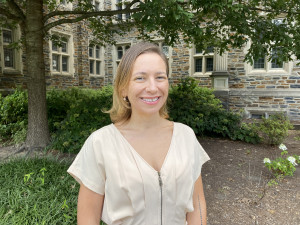
Thompson Writing Program Builds Spaces of Trust in the First-Year Experience
Sharing your writing is hard.
There’s a vulnerability that comes with letting others see your words in print, and establishing trust is the cornerstone of any successful writing class.
Faculty in the Thompson Writing Program (TWP) have been building that trust — and community — since 2000, when the program was established to amplify the importance of writing in the undergraduate curriculum.
With the launch of the Arts & Sciences new curriculum for students entering in Fall 2025, the Thompson Writing Program will continue to play an integral, and now updated, role in the lives of first-year students.
Providing a space for growth
All Duke students take Academic Writing, a course that introduces them to the discipline, during their first year on campus. These classes are small, with an enrollment of no more than 15 in each section.
“The new curriculum doesn’t change the class size or rigor of the required first-year writing courses,” said Denise Comer, professor of the practice and director of the Thompson Writing Program, “but we've revised first-year writing learning outcomes based on new challenges students are facing.” In addition to gaining the still invaluable practice that comes with brainstorming, drafting, revising, giving feedback and editing, the program has added emphasis on the ethics of writing to be more intentional about helping students navigate misinformation and disinformation, as well as learn how to use AI tools responsibly.
Comer also stressed that, contrary to popular belief, writing classes don’t just focus on text printed on a paper or screen. “The opportunities and expectations around academic writing in the university are nuanced and capacious,” she said. “If we think about writing broadly, it includes not only traditional forms of academic argument and research-based essays but also other kinds of media like podcasts, infographics, verbal presentations and photographic essays.” Preparing students to communicate effectively in an academic setting means taking into account the variety of tools available, as well as teaching them to choose what methods and media are most useful in different disciplines and contexts.
Faculty often employ creative teaching strategies and alternative grading in first-year Academic Writing classes. Comer emphasized that these methods, such as portfolios, labor-based grading, and multi-modal writing, will continue in the new curriculum. “The idea of having one deadline for a final paper at the end of a semester that's going to be 50% of the student’s course grade doesn't match with what we know about how writing evolves,” she said. “Through iterative practice, writers get better. Through iterative drafting and revision, a piece of writing gets better.”
And then there’s trust.
Students enrolled in Constellations — a feature of the new curriculum that provides a cohort-based, first-year experience made up of interconnected courses exploring a topic from multiple perspectives — will fulfill their Academic Writing class as an integrated part of their Constellation.
“The great thing for students is that they're going to have the opportunity to have multidisciplinary perspectives about a concept they're interested in and which they will see other students caring about,” Comer said. “It will be a community of learners.”
First-year writing classes are spaces that have already enacted much of what the Constellations will do in terms of creating connections between students, and Comer believes being integrated into the Constellations will reinforce these relationships on an even deeper level.
“The 15-person class, where students are sharing writing and providing feedback and exploring perspectives together, has always been a site of community formation,” she said. “If writers don't have a sense of trust and belonging in a space, they’re not going to be as comfortable sharing their writing.”








